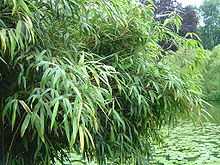Fargesia
| Fargesia | |
|---|---|
 | |
| Fargesia nitida in the Münster Botanical Gardens | |
| Scientific classification | |
| Kingdom: | Plantae |
| (unranked): | Angiosperms |
| (unranked): | Monocots |
| (unranked): | Commelinids |
| Order: | Poales |
| Family: | Poaceae |
| Subfamily: | Bambusoideae |
| Supertribe: | Bambusodae |
| Tribe: | Bambuseae |
| Subtribe: | Arundinariinae |
| Genus: | Fargesia Franch. |
| Species | |
| |
Fargesia is a genus of flowering plants in the bamboo family Poaceae. They are medium to small mountain clumping bamboos, native to alpine conifer forests of East Asia, from China south to Vietnam and west to the eastern slopes of the Himalayas. They are known in Chinese as jian zhu (Chinese: 箭竹; pinyin: jiànzhú), meaning "arrow bamboo". There are currently about 90 recognised species, but morphological and genetic analysis has led to many being transferred to the genera Thamnocalamus, Yushania and Borinda, while others are still incertae sedis.[1] The scientific name was given in honour of the French missionary and amateur botanist Père Paul Guillaume Farges.
Fargesias are some of the world's most hardy bamboos, and they do not spread vigorously. Common bamboos in the genus Fargesia are essential foods for the pandas, and the recent flowering of Fargesia nitida has had a devastating effect[citation needed].
Because fargesias are becoming more well known for their thick clumping habits, they have become cheaper and available at many nurseries.
Taxonomy
This genus is sometimes considered a synonym of Thamnocalamus.
References
- ↑ Li, De-Zhu; Guo, Zhenhua; Stapleton, Chris (2007), "Fargesia rufa", in Wu, Z. Y.; Raven, P.H.; Hong, D.Y., Flora of China 22, Beijing: Science Press; St. Louis: Missouri Botanical Garden Press, p. 74, retrieved 2007-07-16
External links
![]() Media related to Fargesia at Wikimedia Commons
Media related to Fargesia at Wikimedia Commons